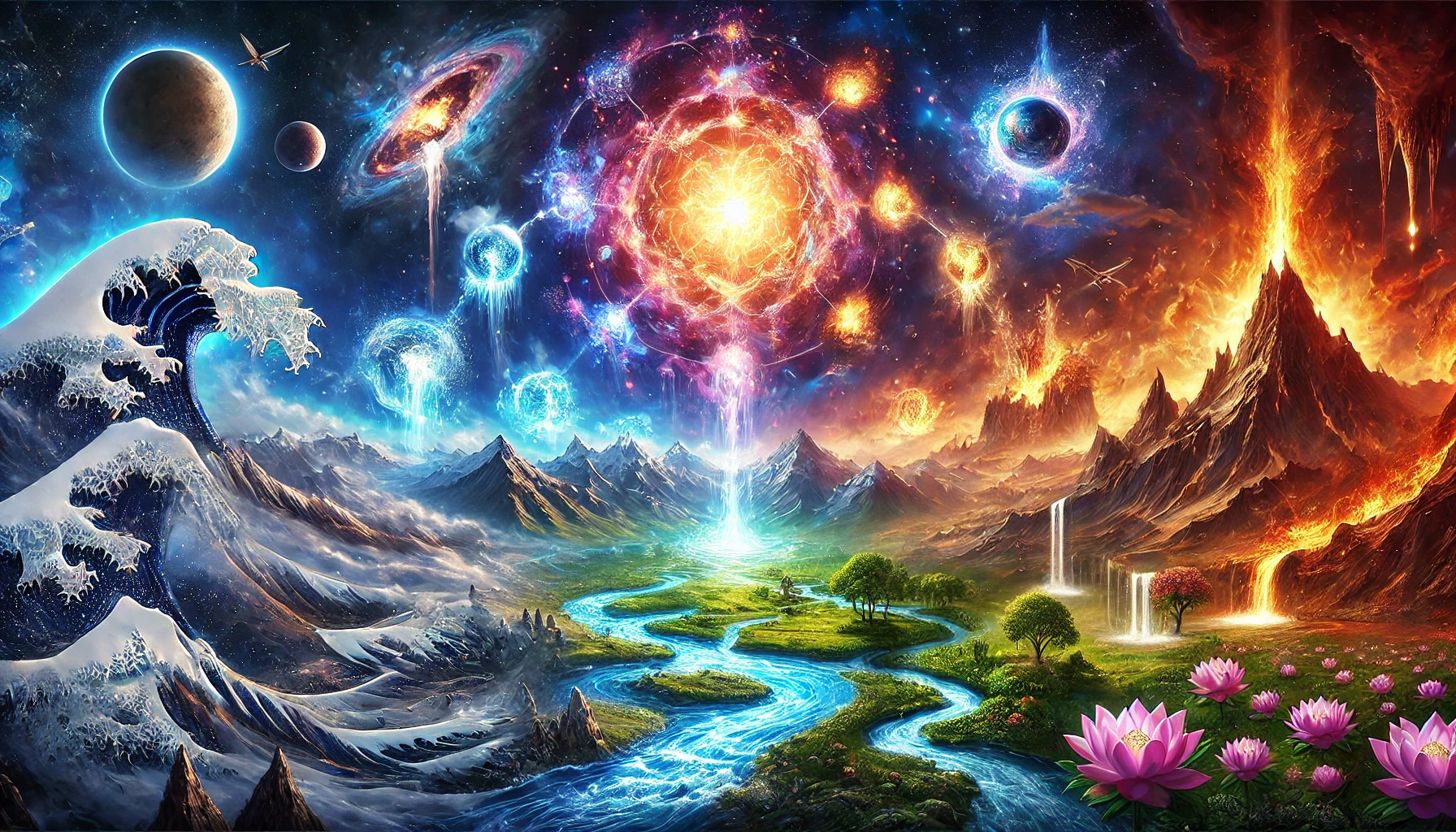Understanding the Evolution of the Universe
Creation is one of the most profound mysteries that has puzzled humanity for ages. How did the universe come into existence? What is the process behind the formation of matter and life? The Śrīmad-Bhāgavatam provides a detailed and systematic explanation of how the universe evolved from the subtle to the gross, under the supervision of the Supreme Personality of Godhead.
In Śrīmad-Bhāgavatam (2.5.26-29), the gradual process of creation is described, illustrating how the five gross material elements—sky, air, fire, water, and earth—were created step-by-step, each element evolving from the previous one.
The Sequence of Creation: From Subtle to Gross
- Creation of Sky (Ether/Space) – The Element of Sound
The first element created was sky or ether (ākāśa), which carries the quality of sound. Sound is the subtlest of all sense perceptions and serves as the foundation for further creation. - Creation of Air – The Element of Touch
From the transformation of the sky, air (vāyu) was generated. Air carries both sound (from the sky) and the new quality of touch. Air also brings life, movement, and energy into creation. - Creation of Fire – The Element of Form
As air further transformed, fire (tejas) was produced. Fire introduced the quality of form or shape. Fire carries sound and touch and adds sight, giving form and visibility to matter. - Creation of Water – The Element of Taste
Fire, when transformed, gave rise to water (jala), introducing the quality of taste. Water carries the qualities of sound, touch, and form, and it becomes the medium for sustaining life and growth. - Creation of Earth – The Element of Smell
From the transformation of water, earth (pṛthvī) was formed, introducing the final and grossest quality: smell. Earth embodies all five qualities—sound, touch, form, taste, and smell—and is the most diverse and variegated element, giving rise to mountains, rivers, plants, animals, and humans.
Simplifying the Creation Process
| Element | Sense Quality Introduced | Cumulative Qualities | Function in Creation |
|---|---|---|---|
| Sky (Ether) | Sound | Sound | Space for sound vibrations to exist |
| Air | Touch | Sound + Touch | Movement, breath, life force |
| Fire | Form (Sight) | Sound + Touch + Form | Light, heat, transformation |
| Water | Taste | Sound + Touch + Form + Taste | Fluidity, nourishment, life sustenance |
| Earth | Smell | Sound + Touch + Form + Taste + Smell | Structure, growth, and variegated life |
Each element is not independent but evolves from the transformation of the previous one, reflecting a divinely guided and interconnected creation process.
The Supreme Cause Behind Creation
While the materialists may study the material elements and their transformations, the Śrīmad-Bhāgavatam emphasizes that behind this entire creation is the Supreme Lord, Krishna, who is the cause of all causes.
Krishna confirms this in the Bhagavad-gītā (10.8):
“ahaṁ sarvasya prabhavo
mattaḥ sarvaṁ pravartate”
“I am the source of all spiritual and material worlds. Everything emanates from Me.”
The Lord, in His form as Mahā-Viṣṇu, lies in the causal ocean and breathes out countless universes. Through His expansion as Garbhodakaśāyī Viṣṇu, He enters each universe, and as Kṣīrodakaśāyī Viṣṇu, He enters every atom and the heart of every living being as the Supersoul (Paramātmā).
Thus, all material elements and their transformations originate from His will. Without His presence, even the elements cannot interact or evolve.
Understanding the Sense Perceptions in Creation
The process of creation is not just about forming matter but also about developing sense perceptions:
- Sound (Śabda): Originates in ether, allowing communication and vibration.
- Touch (Sparśa): Emerges in air, enabling movement and sensation.
- Form (Rūpa): Brought by fire, giving shape and color.
- Taste (Rasa): Comes from water, nourishing living beings.
- Smell (Gandha): Perfected in earth, enabling full variegation in creation.
This progressive development of senses mirrors the gradual complexity in creation, with each stage becoming more tangible and diverse.
Lessons for Modern Civilization
The Bhāgavatam not only explains the process of creation but also guides us on how to live in harmony with it.
Today’s civilization heavily focuses on exploiting the material elements (especially earth, water, and fire) without understanding their divine origin. This ignorance leads to environmental degradation, mental stress, and spiritual emptiness.
By recognizing that all elements are Krishna’s energies, we can:
- Respect Nature: Use resources responsibly, knowing they belong to Krishna.
- Simplify Life: Reduce material demands and focus on spiritual growth.
- Practice Devotion: Offer our work and resources in service to Krishna.
Krishna advises in the Bhagavad-gītā (9.27):
“yat karoṣi yad aśnāsi yaj juhoṣi dadāsi yat
yat tapasyasi kaunteya tat kuruṣva mad-arpaṇam”
“Whatever you do, whatever you eat, whatever you offer or give away, and whatever austerities you perform—do that as an offering to Me.”
Call to Action: Recognize the Divine in Creation
Reflect on the elements that sustain your life—the air you breathe, the water you drink, the earth you walk upon.
- Do you recognize these as Krishna’s gifts?
- Are you using them to serve Him or simply for personal enjoyment?
Śrīla Prabhupāda emphasized:
“Everything belongs to Krishna, and it must be used in His service. This is the true understanding of creation.”
Let us acknowledge the Supreme Lord as the ultimate source of all creation and engage our lives in His loving service.
See His hand in every breeze, every drop of water, every grain of earth.
Surrender. Serve. Realize.
By aligning with Krishna’s divine creation, we will find peace, purpose, and eternal joy.




